|
BREATHING :
Like most physical activities karate relies to some extent on correct breathing, breathing must be learnt to become part of your technique as an instinctive subconscious reaction. Just to breathe is not enough. Exhaling aids the contraction of certain muscle groups, while inhaling performs the opposite by relaxing them. Applying this to karate will promote stronger techniques, muscle groups and reduced injuries. As mentioned, Taoism and Taoist meditations are tremendously popular these days, references seem to appear in a wide range of literature from philosophy, spiritual to art.
One of the central Tao concepts is breath. As a professional in the medical sector I can write pages on this subject, but basically we breathe to survive, the air inspired provides oxygen for our body, the expired breath removes unwanted waste gases, breathing supplies and cleanses the body.
Taoism says, as we breathe so does the universe, when the world breathes all things remain, life is breath and breath is life. This is never truer than when we resuscitate a collapsed non-breathing person. Here again this must be learnt, even professionals need to learn the basics of breathing.
In meditation inspiration is through the nose and expiration through the mouth, breathing consciously slow and deep, it comes deep from the abdomen, through the diaphragm up into the chest and well controlled. Karate techniques dictate the level and type of breathing needed, some times when performing a Kata breathing will be as in meditation, deep, slow and powerful. However, when training, sparring or fighting the breathing technique changes, inspired breath through the nose is quick, it is still deep and powerful, the lungs are filled in readiness. On expiration the breath is forced out of the mouth, completely emptying the lungs, at the same time the bodies muscles are contracted, this does five things:
Empties the lungs of air, to reduce the chance of winding if struck.
Contraction of the muscles will reduce the incidence of winding, if the lungs have not been completely emptied,
Muscle contraction will reduce the degree of pain and trauma sustained if struck.
The exassibated expiration can increase the power of ones own attacks or defence.
When the air is forced out through the mouth it is used to Kai, this is a loud noise;apart from scaring the living daylights out of an unsuspecting opponent, too Kai increases the power by releasing the bodies tension. Those new to karate often shout the word Kai, this should not happen as each persons Kai comes from within, it is a sound not a word.
Breathing and Meditation
:
Breathing is one of the most important functions in a person's body. It is essential to human life. When a baby is born, he breathes using the diaphragm or lower abdomen. This is natural breathing. At some point during our lives we begin to breathe using the upper chest. This more shallow type of breathing is caused by many factors, including stress. In times of stress the abdominal muscles tense up and make it almost impossible to breathe deeply and naturally.
In order to get back to natural deep breathing, or as it is sometimes called, "belly breathing", a person needs to concentrate on his breathing and practice using the lower abdomen to draw in the air. This is done by tightening the abdomen to exhale. Karate practice is one way to develop good breathing habits, another is through meditation.
In order to bring maximum power to a technique, the karate practitioner should exhale on point of contact. To practice this, execute a technique slowly at first and just at point of contact exhale out through the mouth. As soon as you have exhaled, immediately inhale through the nose. Do not make your exhale overly audible. A loud or puffing type exhale has a tendency to drain your energy instead of renewing it.
Meditation practice develops abdominal breathing and ki, or inner energy. To understand what is accomplished by meditation, try to think of the mind as two parts: conscious and subconscious. The conscious mind is the part that gives thoughts and direction to the body. An example of that would be when you execute a technique. Your conscious mind tells your body to do a center kick. The leg then executes the kick. An example of the subconscious mind at work might be when you are reading a book and you suddenly find that, even though you are reading the words, other thoughts have entered your conscious mind. These thoughts have entered from the subconscious without you being consciously aware. Sometimes it can be referred to as daydreaming.
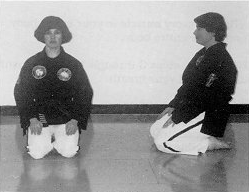
In meditation you try to consciously control what you are thinking about. You concentrate on a particular object that you visualize in your mind or perhaps concentrate on your left hand and try to make it warm. When other thoughts, or distractions from the subconscious, enter your mind, push them out as soon as you become aware of them. By doing, this you practice concentration.
Meditation can be practiced anywhere and in any position, but it is a good idea to practice sitting on your heels (see Figure), also called the zazen position. Keep the back straight and head erect.
Breathe slowly, deeply, and evenly, in through the nose and out through the mouth, using the lower abdomen. When breathing in, imagine that the air is flowing in through the nose to the back of the skull and down the spinal column to the lower abdomen. Think of the breath collecting at a spot a few inches below the navel. Hold the air in for a few seconds then begin to slowly exhale.
As you exhale, imagine the breath flowing from the lower abdomen up the front of the body and out through the mouth. Control the air that flows out the mouth by making a slight "ah" sound. Concentrate on making the sound smoothly and uninterrupted.
As soon as all of the air has been expelled, hold the position for a few seconds before beginning to inhale in through the nose
Elements
of Kata Development
In the system of martial arts that we study Okinawan
Shorin Ryu we use "kata" or forms as a training tool. A kata is
defined as a prearranged series of blocks, kicks and punches against one
or more opponents in a fighting situation. As a student advances in rank
they learn more complex forms such as anaku, empi sho and go pi sho.
But no matter what form you as a student are working on there are certain
elements of a kata that one should always focus on.
1) Learn the Pattern:
The first element a student needs to
concentrate on when learning a kata is it's pattern. By pattern I am
referring to the movements in the form and their sequence. It is
very important that the student commits to memory the steps of a kata
exactly as he is taught. No deviation in allowed. Blocks, punches and
kicks must be done to the correct location. The karateka should make
sure he or she is moving to and fro in the kata at the correct angles.
Moving at incorrect angles is a common mistake when learning a form.
A good way to determine if you are moving at the correct angles would be
to check where you finish the kata and compare it to where you started.
You should not be more then one step off in any direction from your
starting position. In order for a student to learn the pattern of a kata
he must perform the kata repetitively. It is important for a student
to understand that repetition is the key to becoming a successful martial
artist.
2) Breath Control:
In order to maintain the energy necessary
to work a kata correctly the karateka must learn to breath correctly.
Correct breathing is a critical element in energy management. Proper
energy management will ensure the martial artist is able to complete
the kata with consistent power and effective technique. Recently
Psychologist have begun to teach breathing techniques to their patients.
They have learned that proper breathing has a claming effect on both body
and mind. We as martial artist should trained to breath correctly in
order to overcome obstacles such as fear, anxiety, stress and physical
exertions. However just as proper breathing will assist an
individual in a combative situation improper breathing will have an
equally negative effect. When your breathing is out of control you
change the oxygen and nitrogen levels in your bloodstream. This change
will have a adverse effect on your physical, emotional and mental state.
It is vital that the karateka is able to control their breathing in order
to properly manage their energy while working kata.
There are two type of breathing use when performing a kata.
The first is called "ibuki" or quick energy breath. Ibuki
breathing is done at the execution of blocks, kicks and punches
The second is "nogare", or slow breathing. Nogare breathing is
usually done when moving from one position to the next or when there is a
pause in the kata.
Through the practice of proper breathing the student is
able to keep mental composer throughout practice in the dojo and in his
everyday life. Correct breathing will enhance a students mental and
physical endurance as well as his concentration, focus and develop the
warrior spirit necessary to be a good martial artist and Christian.
3) Kiai:
A "kiai" or spirit meeting is an
act where a shout in conjunction with the expulsion of air can reinforce a
strike or a block by maximizing bodily strength. We define a kiai as
a muscle tightening yell that adds power to a technique, reduces shock to
the body and causes your opponent to hesitate. The breath is exhaled very
quickly with a loud yell originating deep in the abdominal area,
tightening the muscles throughout the body. Kiai's are use in several
locations in a kata. A good guideline on when and where to use a
kiai in a kata is at the opening move and at the finishing move of each
opponent in the kata. Remember this is a guideline and not a rule,
in more advanced kata's there may be additional kiai's.
4) Combination and Timing:
A combination refer to two or more
techniques put together in a certain sequence. The are usually
several combinations in every kata. Within this aspect is also the
timing changes that occur within a kata. One way to think of it
would be to compare the techniques in a kata to notes in a musical
composition. The tempo in the music stays the same but the number of
notes in a measure may vary. The tempo of a kata never changes, the tempo
should always reflect the urgency of an actual fighting situation but the
number of techniques in a combination may vary. Proper combinations
and timing keep the kata from being a monotonous pattern of movements and
more accurately depict a real fighting situation. It is important
that the student understand when and where the timing of a kata changes
and why it changes. By practicing correct combinations and timing not only
will the performance of the kata improve but the student will become a
much more effective fighter.
5) Bunkai:
A kata is a story about a fighting
situation against one or more opponents. In order to get the most out of a
kata you need to understand what is going on in the kata. The term "bunkai"
implies form and meaning.
The form aspect applies to having correct body positioning
while executing the movements in the forms. Correct positioning not only
includes the technical accuracy of the techniques used in the kata but
placing your body at correct angles when moving through the kata. Getting
the kata's form correct is one of the hardest aspects of learning a kata.
It will require the karateka to not only be corrected by others but to
also critique himself when working the form.
The "meaning" aspect of bunkai applies to
understanding what is going on in the kata. How many attackers? How many
attacks? How are they attacking, what techniques are they attacking with
and from where are they attacking? What stance are the attackers in? What
are the finishing techniques? In order to really learn a form the
student needs to not only know what movement he is doing in a kata but the
movement of his opponents as well. When this is done the karateka
can then visualize his attackers and fully understand the techniques in
the kata and why they work.
6) Head Snaps:
How can you attack or block what you don't
see? When working a kata the karateka must initially look then move.
Head snaps must become automatic in order for a kata to resemble a
fighting situation. A good idea is to incorporate the head snap with the
previous technique, visualize the attacker in your mind then make the next
movement in the kata.
Another aspect of head snaps deals with your eye's and
what they tell an opponent about you. You must train your eyes to convey
concentration and strength when working a kata. Without projecting this
"warrior spirit" from your eyes your kata becomes dead and
lifeless. Always remember that projecting that warrior spirit from your
eye's can psychologically defeat an opponent.
7) Tension:
Tension is another aspect of energy
management. Being tense too much in a kata will rob you of power. There is
a correct time to be relaxed and there is a correct time to be tense in a
kata. A good example is when punching, the arm and fist are not tense
until just before impact. Being relax while working a form will not only
increase your power but allow you to move fluidly throughout the kata.
Karate: A Beginners Point of View
I find that Karate, like so many other
hobbies, starts as something you would like to try and experience but
suddenly, and almost unexpectedly grows on you. Not only that, but I often
finding myself wanting to do more Karate, and counting down the days till'
my next training session.
At first the prospect of training with so
many others who have already gained a respectable grade, is a little
daunting. No matter how many times your told "everyone starts the
same" you still feel as if all eyes are on you. In time this passes,
and as you get to know your fellow Karateka and gain a little of their aid
and knowledge, you feel more of a team than an individual.
When I first begun Karate, roughly four
month ago, the whole prospect was a little alien. Although I'd seen it
done and had a little go at the basic punch or two, it still turned out
very different from what you expect. This time last March I would have
been sitting infront of the TV, marveling at the martial arts films, where
as now I would be laughing at them. There is a more serious, realistic
term to Karate that many people who have never experienced it don't
realize.
I've found that Karate as developed from a
hobby into a necessity of my weekly life; perhaps like shopping for food.
It's a pursuit that requires a lot of dedication, and I find it is also a
release from the real world. What ever is happening in my life that is
either good or bad never follows me into the dojo. All problems are
forgotten.
Progress is slow, but if you don't solely
seek to become a higher grade, you'll find that the time will fly and your
grading will suddenly be upon you. Many people who begin Karate expect to
become a black belt in no time. This must always be eliminated quickly, so
as you never become disappointed in your progress. One life time is not
enough. Patience and understanding are required, as well as physical
prowess. Bill (my black belt beginners class instructor) once told me that
once a karateka have become a master, they are in a certain point of view
once again a red belt. When you begin Karate you know nothing. Once you
reach the highest standard, you may know much but you'll never know it
all. So why train? Ill tell you why: It gives you self confidence,
discipline, fitness, helps to channel aggression in a positive way, and
gives the opportunity to experience and learn as much as possible. Great
moral principles are not fixed. We need to pursue to the limit all that
can be learnt in this life (the Buddhist philosophy - Daido Mumon).
This, as well as utter enjoyment of the sport, is what drives me on to
learn more Karate.
Myths
about DIM-MAK ["Death Touch"
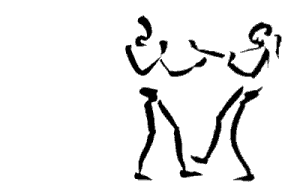
ATEMI-WAZA: STRIKING THE VITAL POINTS
Without a doubt, more myths exist about
this subject than any other in the "Martial Arts". Stories about
“delayed death touches”, knocking out a person by just touching them,
"secret" nerve strikes or pressure points, abound. TO DATE I
have yet to see ANY scientific proof of the actual existence of these
techniques.
In my opinion these “stories” are told
by instructors to keep students by the promise of "occult
knowledge". Who wouldn't spend money to learn secret knowledge that
would give us great power over others. Also, it allows the instructor to
keep the training at a level that will keep students, instead of driving
them away.
Keep in mind that most schools come from a
"sporting" or "traditional" base. I strongly believe
in using sporting events to develop certain skills, but if the end goal is
winning a medal, then you will never learn effective self-protection
methods.
The problem with the
"traditional" approach is we are in the 1990's. What someone
thought was a wonderful idea when men rode horses and used swords, may be
a stupid idea now that goblins travel in packs, armed with assault
weapons! The person running the school is in business to make money, as
they should be. But the things a person needs to do to prepare themselves
to survive a violent assault, are things that drive the paying student out
the door.
Other schools are teaching a "new
age" religion. Filling students heads with nonsense about mystical
powers, secret techniques, and "death touches". It's no wonder
when the average "martial artist" finds him/her self in a
violent encounter, they end up a battered loser! If a .38 special bullet
fired into a person only stops them about 50% of the time, JUST HOW
EFFECTIVE DO YOU REALLY THINK A PUNCH OR KICK IS?
"Well, I'll just use Dim Mak or
Kyusho-jutsu to hit nerve centers that would drop an elephant". No,
you won't! Do you know what the "Tache-Psyche" effect is, and
what it does to you? When you're looking the Goblin in the eye, and you're
in the grip of "tache-psyche", the motor skills of the fingers
and hands break down! Slap, tap, rap, or nerve strikes to spots the size
of a dime, are IMPOSSIBLE under extreme stress. Believe me, when you are
looking at six men who plan to beat you to death, you're going to be under
stress.
ATEMI-WAZA:
ATE-WAZA (Striking techniques)
MI-WAZA (Vital Points)
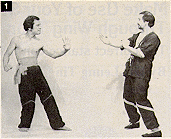
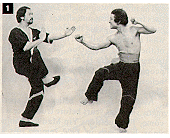
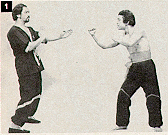
The simple reality of combat is that we
must keep this stuff very simple. Strikes like the heel hand/tiger claw
are high on the list as they do great damage with little harm to the hand.
In terms of vital points it is simple; the
primary attack targets are the eye and the instep. Simply because if he
can not see you, or chase you, you can escape.
If a primary target is not open; then use a
secondary target (nose, throat, groin, knee) to open up a primary one.
Note: the groin is a secondary target
because many attackers wear a cup as they know they are going to be
attacking people.
In combatives, the use of Atemi-Waza is to
prevent our attacker from thinking about anything other than pain. You
cannot think of two things at the same time. It can't be done. If you're
thinking about what just hit you (called "damage assessment"),
then you can't think about hitting! It is very important that you develop
the ability to find, and strike, these areas under any and all conditions.
Your life, or the lives of your loved ones, could one day depend on your
ability at Atemi Waza.
Actually, the pressue point strikes in
Kyushu-jitsu can and have been proven by Western medicine. The knock out
points are nothing more than compressing an artery(like a choke, perhaps)
for split second which can cause a momentary drop in blood pressure,
causing a knockout. Don't believe me? Every KO in prizefighting history
was caused by striking a point on the body that appears on the meridian
maps of every massage therapist(the temple, the hinge of the jaw, the
chin, or even the solar plexis). All pressure point manipulations,
however, as I said, their validity can be proven by Western medicine (as
well as by the experiences of many of us in the dojo). Since the validity
of these points can be proven, that means that there is no
"magic" to me at all. Explained to me by one of my instructors,
who has a black belt in Kyushu/Tiute-jitsu, modified by me. In closing, I
think you should be careful how you debunk the fakes and posers out there
for using "mystical" techniques, because I know for a fact that
you have defeated opponents by manipulating their gall bladder meridian.
Don't believe me? Look at the massage therapist dummy. You will see that
the gall bladder meridian runs up the neck. When you use Hadaka-Jime to
manipulate the gall bladder meridian, you are cutting off blood flow to
the brain. No magic involved, just Biology and Physiology.
What I said was; under extreme stress they
require a degree of hand eye skill that is all but impossible for the
average person to do.
However; I have been to the seminars by the
pressure point masters; and was knocked down by one...
In reality he walked past me and sucker
punched me.
Not what I would term a "pressure
point" KO...
Much of this is simple auto-suggestion and
proper testing would require that you eliminate that from the mix. I have
often thought if you brought in an old chinese guy who had NO knowledge of
pressure points; but you made people think he did; how many people would
drop when he touched them (remember the aikido story).
For combatives the skill level needed to
hit that correctly simply isn't there. I have video of police in gun
battles as close as 7 feet and even though BOTH men empty their firearms,
NO ONE gets hit.
"When you use Hadaka-Jime to manipulate the
gall bladder meridian, you are cutting off blood flow to the brain. No
magic involved, just Biology and Physiology. "
Actually; that is not correct. There are various
places on the web where Judo's art of Shime-waza is discussed at great
length.
You will find that it is about blook pressure not
blood flow that is the reason the person passes out; and that the gall
bladder doesn't have a thing to do with it.
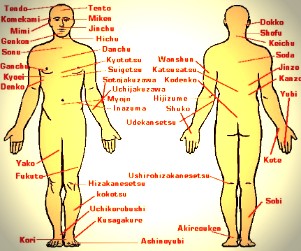
Please click here to see
"Pressure Point Fighting Art"
Taijiquan self-defence
:
There is no ‘soft’ way to fight someone or to defend yourself. No possible way to defend yourself and not harm the opponent! However, how many times do you hear that Taiji is the ‘soft’ martial art that can be used to ‘gently’ put someone down.
Part of the attraction to many people who take up Taiji is that fact that they do not wish to ‘get their hands dirty’ in defending themselves or their friends and loved ones. They are lured into a Taijiquan school with the promise of being able to control an attacker without hurting him. In my opinion, and it is only my opinion as many disagree with me on this, that you should immediately walk out of a class where the instructor promises such ridiculous things. It is not only fraudulent but also dangerous to the student because he is being fooled into a false sense of security.
Taijiquan is called the "Supreme Ultimate Fist", and although I do not agree with calling any martial art by such a lofty name, the art of Taijiquan does in some ways deserve this title. However, it does not deserve this title based upon the way that most people sadly teach the art for self-defence. Only this week I was reading yet another ludicrous article in one of the World’s leading U.S. martial arts magazines where someone was advocating grabbing the arm of an attacker and using the posture known as ‘Lu’ to put him onto the ground! You know the old scenario, he attacks with a punch, you block using p’eng’, (Photo No. 1), and then you use ‘Roll-back’, (Photo No. 2) to put him onto the ground face first! Using this method, the young woman who was featured in the article would have been severely damaged by the attacker! Even if one could get the attacker to this point, what do you do then? Walk away and allow him to get up and re-attack?
Taijiquan is deadly, it is dirty and it is one of the best self-defence systems known. Only when it is taught as it was originally intended though, as a hands-on, energetic fighting system where anything goes in order to survive in a realistic street attack.
In order to utilise the true nature of Taijiquan self-defence, and get right away from the derisive techniques that many teach using only the basic forms, we must learn a little about the ‘small frame’ form and how it is used. For instance, the above method in a realistic attack would be used as follows. As he attacks, move forward (not back) using p’eng, (Photo No. 3). A very quick ‘roll back’ as you are still moving forward into his face, (Photo No. 4), then attack with palm or fists to his vital points around the head and neck. (Photo No. 5) & (Photo No. 6). Then, and only then, provided that he is alone, take his legs out, (Photo No. 7) using another of the small frame postures, and follow him to the ground with fingers to the eyes. (Photo No. 8). Then you can control the attacker! It is a rule of Internal Gung-Fu fighting that we never go to the ground when there is more than one against you.
There are no pulls or pushes in Taijiquan! This often sounds strange to many who practice what I call ‘silly Taiji’. The reason that most people advocate the use of push and pull in self-defence using Taijiquan is that there are many mistranslations in the classic Taiji translations. We only ever use ‘pushes’ in training. The reason for this is that if we were actually to strike our training partners, they would be hurt and the closest thing that we can get to realism to test our own power is to push. However, this is only in training! To do this in the street against someone who was out to get you, would invite defeat. What are you going to do, push him into the path of an on-coming car! Same with any pulls, he will just come back, even more pumped up and angry because his ego has been hurt. Pushes in fact are deadly dim-mak point strikes usually to those points around the chest area such as ST 15 and ST 16 (Stomach point No. 15 & 16), these points will send a person into knock out easily when performed correctly. By the same token, the pulls are only there in training and not for reality.
The games (training methods) teach us certain rules for self-defence. I will document many of them here, however, it is important that you do not just read about these rules and try to intellectualise them, but rather do the training methods in order to gain the necessary body mechanics.
1/. Never step backwards.
When you are attacked, do not do what most hard style martial arts teach you to do, to step backwards as you block! This will invite certain defeat. Any fighters or brawlers all work on ‘switches’. We are born with switches that tell us to do certain things sub-consciously, like a male puppy that, at a certain age begins to lift his leg, why? He may not have seen any other dogs doing this but he does it anyway as if some programmer has programmed a computer program into his brain. This is not far from the truth. We are all born with switches, those that tell us to cry, to begin crawling etc. Then there are those switches that we learn from experience. It is the same with the qi that we are born with (pre-natal qi) and that which we gain as we grow (post-natal qi).
A fighter learns certain switches as he becomes increasingly experienced at fighting and aggression. However, it is also these learned switches that can bring him unstuck in a fighting situation against someone who knows about switches. The fighter learns these switches but also learns sub-consciously that his switches will also cause other switches in those who he is attacking, which will in turn switch on more switches in himself. A fighter works this way. He may not know this and indeed, it would be rare that any street fighter would know about such things. So, when the expected switch does not happen when he attacks someone, it throws his own switches out of whack, thus putting his timing and co-ordination off. This is where internal Gung-fu gains the upper hand. We know that the fighter expects us to react in a certain learned manner when attacked or when faced with aggression. He expects us to move away from him trying to lessen his attack. So he is ready for this and knows exactly what to do when we do this expected movement. But if we do not, then he is taken by surprise and before he has time to change his method, we have already finished it.
Someone who is attacking you expects you to be where you are when he attacks otherwise he would not have attacked you where you were. Someone throws a punch for instance, they do not throw the punch to where they think you might be, but to where you are at the time of the attack. Remember though, the attacker is expecting you to either be there or to move backwards. So even if you do move back, he is ready for this and will launch another attack to compensate for this movement. So, if you are not where he expects you to be, and more importantly, if you are in his face attacking him, then he is just not ready for this. He has to re-group and think about what he has to do next, giving you time to attack with devastating attacks from the internal Gung-fu system.
Often when we train in techniques or training methods, we will be taught to stand still and not move. However, this is only in the beginning to get the movement correct. Once you have it, then you begin training in a more realistic manner by moving into the attacker as he attacks.
There is another important reason in self-defence for not taking a step backward apart from the obvious physical advantages as I have indicated above. And it is an ‘internal’ reason. The ‘primordial’ instinct for survival is inside all animals including human beings. Although ours has been slowly lost over the years of depending upon others for our defence! It is still in there, but we just have to get at it in some way. Dogs for instance have all kinds of primordial instincts like, at a certain age when a male dog begins to lift its leg to pee. Why does it do this? Well, we know why I guess, some chemical changes happen inside causing the dog to have a need to mark its territory. But how it happens is a complete source of mystery and wonderment to me. Never having seen another male dog, the puppy will always begin to lift his leg at a certain age. He will also at this age, begin to attack, i.e., move forward into his ‘opponent’. In order to understand this, we must also know a little about the ‘triune brain’, or the ‘reptile brain’.
The theory goes, that when God, (or whoever) was making we animals, he began with his first creation, the ‘reptile brain’ which is that brain that all reptiles have. It is a survival brain, totally relying upon instinct and programming, no thought, only reflex reactions caused by its particular ‘computer’ programming. A snake does not ‘think’, it does not love, hate or feel resentment etc., it just lives and survives. This is the kind of brain that the snake has. We too have this brain! However, it is only 5% of our total brain size.
Then ‘God’ tried out a new brain for the more complex animals such as mammals and we call this brain the ‘old mammalian’ brain. This is that brain that dogs have for instance. A little more thinking for itself and some small amount of emotion even, but still much programming and relying upon instinct and reflexive actions to stimuli. The dog however is able to revert to its ‘reptile brain’ any time there is an emergency of survival. In addition, it makes certain body changes to enhance this effect to give it the greatest chance at surviving. Like arching its back as all animals do including sharks just before they attack. We in internal Gung-fu also make use of this when we are attacked. The animal also makes use of another area of helping it reflexively to go into the reptile brain. That of always rushing forward. You will only notice this phenomenon in those animals that are closer to the source of ‘wild’ than many domesticated animals who have also (as we humans) had this sense bred out! Like the Australian Blue Heeler dog that is part Dingo. He is one of the most courageous small dogs on earth. Not because he is courageous however, but because he is closer to the source than most dogs. There is in fact an old saying with regard to this breed of dog here in Australia; "the Blue Cattle Dog (the breed has several names and also comes in the red variety), will eat anything it meets unless it is eaten first".
The last and most sophisticated brain is of course the mammalian (human) brain. However, this brain did not replace the old mammalian or the reptile brain, it simply was placed over the other two. So we as humans still have the ‘survival brain’ and are able to access this animal brain through training. This training is part of the internal Gung-fu training.
One way that we have to access this reflexive survival brain is simply to move forward as we are attacked. It triggers a switch that causes us to attack and attack again! Just as an animal never stops its attack, so too should we do the same. In my classes when I am teaching the training methods, I have to begin by teaching them incorrectly! This is because if I were to teach the correct way, i.e., moving in as we are attacked in training, we would have many more injuries! Moving in seems to build up an attack energy that is often uncontrollable in the beginner. Even the blocking type movements have far greater impact when the reptile brain kicks in. In addition, it is only those who are trained as advanced instructors that I allow to train in this manner.
2/. Never fight the peripheral-attacking weapon, fight the whole body.
This is a big mistake made by many highly ranked martial artists; they block the attacking arm or leg standing still! They do not move into the attack as they block, they just stand there and block the attack. If you can touch his arm, then you can touch his body and if you can touch his body then you can strike him. Never wait for the attacking portion such as a fist to reach you before you do something about it. See his whole body using ‘eagle vision’; react to what his body is doing rather than to what his arm is doing. In order to attack you, the attacker MUST firstly move his body. Try it now; try punching without moving any other part of your body other than your arm. If you are able to do this, you will have no power at all anyway! So we react to his total body movement not only his arm or leg etc. The very instant he moves any part of his body, attack. Do not worry about what he is going to attack with as his attack will be totally minimised by the fact that you have moved in on him and have closed him up before his attack has had time to even gain any power.
3/. Never meet force on force, always move at a slight angle to the attacker as you move in.
You must move in a ‘V’ shape to either side of the attacker. This will give you deflecting power as well as increased attack power using his power against him. Like a ricochet. If the projectile has nothing to bounce off, it will not have much power, but if it has something solid to bounce off, then its power will be great. The tenser the attacker is, the more power you will gain with which to revert on him. This movement will also put you in complete control because you have your ‘distancing’ correct by using this method. It will place you at exactly the correct place to be in control of the attacker. He will never expect you to do this.
4/. Never use two steps in fighting.
You must always make your defence your attack. Never block, then attack, make your block your attack. His sub-conscious switches tell him that you will attack next after you have blocked. However, if your block becomes your attack, he has not had time to think about it. You have attacked him during the time that he is supposed to attack you! If you block first, then it is his turn to attack because you have asked him to attack now. This is the logical way of the fight, he does something, then you do something, and then he does something. You must change the logical fight into a totally illogical fight, so that his switches are all broken down. Make it a fight of; he attacks, then you attack, then you attack, then you attack! Never give him that slight break when his brain tells him that it is his turn to do something, take his time away from him and use it for yourself. In (Photo No. 1), who is in control of this situation? This is where I have used a so-called hard style type of method of two steps. I have blocked his attack and in (Photo No. 2), I have re-attacked. The attacker is still in control of this situation. However, in (Photo No. 3), I have simultaneously blocked and attacked. Now who is in control? I am. See how the distancing has placed me right in the attacker’s face in total control of his body. I am now able to attack at will.
5/. Never look at the attacking portion.
Eagle vision is a marvellous way of using the eyes. Human beings are so used to focusing on things that we see, that when we do this in fighting we always lose! Why, because you can see much more by not looking than you can by focusing. Eagle vision is that vision that birds have. Humans have a completely different system of vision than birds and it has to do with the way that we get blood to the eye. But we can make use of the way that birds see. An eagle for instance when catching a moving mouse, simply flies down and catches it. It does not focus on the mouse; it uses a kind of peripheral vision to lock onto the mouse’s space. Rather like locking its qi onto that of the mouse. So if the mouse moves, so too does the eagle, the mouse cannot escape unless it goes into a hole. You must see the whole body of the attacker, and not just look at the peripheral that is attacking you. In this way it does not matter what portion he is attacking with, your body will reflexively adjust to the attack and always come back with the correct answer. This is particularly important when we are using dim-mak (death point striking) in a fighting situation. If we were to look for the points, we would always miss them, as we just do not have time enough to look. However, if we use eagle vision, we see the ‘shadows’ of the body, the little hollows where all dim-mak points reside. We see shadows reflexively and are then able to hone in on these shadows to pinpoint the dim-mak point automatically without thinking.
6/. Never use a lock or hold as your main fighting method.
Locks and holds do not work in a realistic fighting situation. I have discovered this aspect of fighting through my own experiences and from that of others who have survived street attacks. It is all right to use a lock to control an attacker once he has been disabled by using a point strike or some other striking disabling method. However, if you try to use a lock or hold against someone who is trying to harm you, then you will lose the confrontation. This is especially important in the street when it is not usual for only one attacker to be attacking you! In these cases, you would never even attempt to use a lock or hold, as his friends would have a chance to attack you at this time. Stun the attacker with a strike to the temple (GB 3) or another vital point, then you are able to take a lock or hold. This is greatly important when fighting against an armed attacker. Most schools will teach that you should grab the hand that is holding the knife or other edged weapon for instance. These methods work fine in the dojo but in reality, you are inviting defeat and or even death to use such methods. You must remember that an attacker, especially one who is holding a knife, must be pumped up in order to have the aggression necessary for such a deadly attack. So grabbing his arm is not going to stop him. In the dojo, you might be able to use a technique like a lunge. But if the attacker is serious about doing you harm, and he knows what he is doing, he will probably make use of his yang energy to rip your hands and arms to shreds before bringing the knife back to kill you.
In the case of an edged weapon remember the three words; evade, bump and attack. Without writing a whole book on knife defence, it goes something like this.
Evade: He perhaps attacks using a lunge. (The same methods work for any type of weapon attack from anywhere). Using a ‘hinge’ type of weapon, you move your body out of the way by slightly turning to the side as you slam his arm so hard that it damages his arm bumping his weapon arm out of the way for that split second. My right palm is already up ready to strike to deadly vital points. In doing this you have done the first two of the words, ‘evade’ and ‘bump’. You have also stuck to the above rules of never backing of and never using a one/two type of method. Your defence has become your attack. Now I am able to strike using deadly methods to points that will either kill or drop him. Then, and only then, when he is down and out should you take the knife. The ‘hinge’ type of attack is also one of those that will bring up the reptile brain causing your energy to build up to a high level for the final attacks.
Click here to go to "THE CHENSTYLE
JOURNAL" Page
(Please do not forget to come back to this site again!)
Using the reptile brain, every time you touch the attacker, your own energy will grow causing you to want to continue. Your own energy system will be enhanced by the fact that you are borrowing his energy and sending it back to him. You are using only one bit of energy and recycling it. In this way you do not feel tired having to block, then build up more energy for the next attack etc. Your first lot of energy (qi) is re-used through the attacker’s body draining him of energy and building yours up

Mas Oyama
(Masutatsu Oyama) the Karate legend :
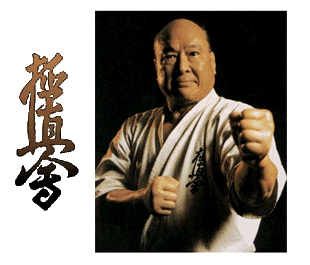
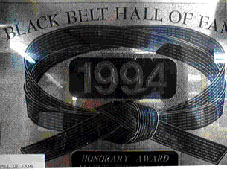

The Oyama Legend :
Oyama was born in Korea and immigrated to Japan as a youngster named Baedel Choi. Little did the people of Japan know that when they pressured the young Choi to take a Japanese name, the name he would choose, Oyama or "great mountain," was to lay the foundation for the karate empire he was destined to build. The young Masutatsu Oyama would eventually become not only the founder of one of the world's largest karate organizations and one of the strongest men alive, but despite the cold welcome he initially received by the Japanese people, he was also destined to be one of the only figures in Japanese history to become a legend during his own lifetime.
Mas Oyama developed an amazingly strong and conditioned body by breaking bricks (1), punching the makiwara (2), and practicing basic techniques repeatedly.
It would be impossible within the limits of this article to give a complete account of the Oyama legend, both because of its complexity and
size. The following story, recounted by his nephew Dr. Seong Soo Choi, is, however, representative of Oyama's life and character:
The setting for this tale is early 1950s Japan. Oyama, who was in his late twenties and had studied under the greatest teachers of the day (including Giko Funakoshi, son of Gichin Funakoshi, the founder of shotokan karate), had recently spent almost two years in total isolation at a secluded mountain site called Kiyozurni. He had lived there single-mindedly in search of the mastery of the martial way. The strength he acquired during this time was so great that one of the first tests he gave himself upon returning to society was to fight against angered bulls bare-handed. He would literally tear the horns off the skulls of raging bulls, and in at least one bout, Oyama killed one of the beasts with a single punch to the head.
Choi's story begins with Oyama in a bar, mourning the death of one of his most beloved students. Although this student's skill and devotion were unequaled, he had constantly gotten himself into trouble because he was unable to control his temper. Oyama, seeing no alternative, had been forced to order the student to leave the training hall and never return. According to Choi, the student's last words, as he committed suicide, were "This is my love for you, Mas Oyama."
Oyama, in his grief-stricken state, drank heavily at the bar that night, Choi claims. When Oyama noticed several men in the bar harassing a woman, he intervened, and one of the men reportedly pulled out a knife and stabbed Oyama in the left forearm. For Oyama, who was accustomed to striking bulls, this "tough guy" was an easy target. Choi claims Oyama delivered one blow, and the man never got up. The police considered the incident justifiable self-defense and did not charge Oyama with a crime, Choi said. However, as Oyama left the police station, he encountered the angry wife and child of the man, according to Choi. Deeply affected by the moment, Oyama realized that, had he been in a more stable frame of mind, he would have been able to avoid the situation, or at least temper his defense somewhat. Oyama reportedly dropped to his knees at the feet of the two and swore that he would never again use his karate.
Choi claims Oyama left his Tokyo dojo and followed the two to their home in the country. Even though they hated him, Oyama, Choi said, built a small shack on the edge of their property and worked their farmland for several months. The woman's son managed to convince a group of boys that there was a crazy man on his property who was trying to hurt his mother. Armed with clubs, they went to the shack and beat Oyama severely, Choi asserted. Oyarna made no attempt to defend himself, for he had sworn to never again use his karate.
When Oyama regained consciousness three days later, he found the woman at his feet. According to Choi she had finally realized Oyama's sincerity, and she begged Oyama to forgive her and her son, and to return to his life of karate.
Oyama's honor is so great that, even though he was capable of killing a bull with a single punch, he allowed a group of boys to beat him into a coma because of an oath he made to two people who hated him.
In Japan today, countless books, feature-length movies and even comic books relate the living legend of Mas Oyama. Now in his seventies, Oyama
taught at the headquarters dojo of the International Karate Organization, Kyokushinkai, in Tokyo. For information, write the organization at No. 3-9, 3-chome, Nishi-lkebu-kuro, Toshima-ku, Tokyo, Japan.
About the author: Davidson, North Carolina-based freelance writer Nathan Ligo studied kyokushin karate in Japan for two years with Matsutatsu Oyama, and has spent another eight years training with Oyama's nephew, Seong Soo Choi, in North Carolina.
Mas Oyama was of Korean descent. He immigrated in Japan in the midst of the nationalist-fascist fury which made the country enter world war 2 and suffer all the harsh consequences. Japanese had their karate and budo officially banned by Mc Arthur who even went so far as to gather the most precious samurai swords from wherever and sink these precious symbols of national pride in Tokyo bay.
Being a foreigner (and especially Korean or Chinese) was a stigmate. He had to build himself the image of a pure traditionalist Japanese lest he didn't want to be an outcast. He was a self-made man in karate when karate was sinking because of western tradition impact and reduced to demonstrative choreography. He went so far as to claim until he died that he was born in Japan and was always very non-fairplay with non-Japanese. Even his Japanese students agree with.
When kyokushin became famous he became tyranic and money-greedy which is a regular thing happening with poor guys who are self-achieved in rough conditions. All his great students agree that the breaking tricks and the bull fights were what Oyama himself called monkey business i.e. fakes made to attract crowds in the game. Both Kenji Kurosaki(cofounder of Japanese kickboxing) and Jon Bluming (founder of MMA style kyokushin-derived called kyokushin budokai) said that he tried to fight first an old meak ox with his horns heavily hammered, that explains the apparent ease with which he slashes the horns.
With the next and stronger bull he almost got killed (stabbed in the spleen and went to surgery), it is anyhow remarcable he had the guts to try !
He did a lot of harm to the kyokushin by arranging bouts in which Europeans faced tough Europeans and the Japanese only their own weak students to have foreigners reach slaughtered in the finals against his crew who was fresh ; even then, when a "gaijin" (foreigner) was winning he threatened the refs to change the decision.
But all of them agree on the pluses. He was a tremenduos coach. He was the single karate coach to take the Thai stylists challenge against Japanese karatekas in 62 under full Thai plus headbutt rules, these were Tadashi Nakamura, Akio Fujiwara (both winners, with Fujiwara being later the first non-Thai to win a Thai national title) and Kenji Kurosaki (lost a unanimous decision if I recall), all of them at the root of Japanese kickboxing. He was a reformer of obsolete Japanese karate style and a decent stylist. You can understand then the psychology of these Japanese winning against the Thais when no Japanese did and not wanting to call themselves Thai stylists even if training under Thai rules - it is a matter of national pride and they can legitimately say they built their own name let them then call themselves how they want what's the harm ?
One can understand also the psychology of Oyama inside a nationalistic country with aggressive trends against foreigners - he fed them the lies they needed to make his way to the top.
Let him rest in peace, be the best for your own all of you.
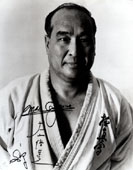
Kyokushin form (kata) :
The stances are conceived to launch kicks with force rather than with speed and also not for allowing series of punches but swift opened-hand techniques derived from crane style and some korean and chinese striking arts and swift punches to the head or heavy punches to the body. The knees are not designed to be thrown from a tight clinch. If they'd go to the ring with such a thing they'd obviously loose, it is still very effective for self-defense and you should keep in mind that sportive kyokushin is not the whole kyokushin, it is just an endurance test to condition fighters for aggression.
In the whole kata syllabus of kyokushin up to 3-dan there is only one (garyu) containing a single roundhouse kick. The legkick with all due respect was in use in Okinawan barecknucle fights of old kempo since the last century as far as I know and it seems it was imported by somewhere from the continent but Oyama might have seen them in use by his Gojuryu master (they were kinda dispised because it was thought they allow too easy a groin knee counter) and never had known they are of Thai origin but just thought he might use them to strenghten a style for sport fight where there is no allowance of groin attacks.
As for how kyokushin looks in respect of karate and not fullcontact sport :
- happoren kata is an image of a modernised chinese crane style (many fingers and palm attacks to neck and face)
- tensho is derived from gojuryu and is centered also on opened hand attacks at the neck and reversed punch attacks to the chin
- yangtsu (from Yang Tse river of China) is a resumed image of basics in local crane style (teep kicks combined with opened hand)
- kankudai which is the one cherished by Oyama is derived from shotokan and contains many sidekicks and throws, elbow strikes, fingers to the eyes and
groinkicks
The kyôkushin-Ryû (School of the ultimate truth/verity) is considered as one of the hardest, effective and the strictest styles of Japanese Karate. It was created at the end of the fifties from a master that became very fast a living legend: Masutatsu Oyama. Masutatsu Oyama was born in Korea in 1923. He starts to practice their two local martial arts: the Tae-Kyon and the Tae-Kwon-Pup. He also learns some kinds of wrestling and at the same time the Chinese and the Japanese Kenpô. In 1936 Masutatsu si in Tokyo where he starts to practice Jûdô. In 1938 he continues with Shôtôkan at the school directed from Gichin Funakoshi and Yoshitaka. After a while he told about Shôtôkan: “I did not like to control my techniques, so I left…”
Oyama searched in Karate something else that he learned with the group Funakoshi. In 1940 he leaves Shôtôkan because the son of Funakoshi, Yoshitaka lost a fight with a Gôjû-Ryû expert. He judged this style as not effective. Masutatsu becomes a disciple of Master Sô Neishu who is one of the assistants of Gôgen Yamagushi, the founder of the Gôjû-Ryû. He practices with an exceptional will and an immense intensity. In 1947 he participates in Kyôto to a championship, which grouped the popular Karate schools of Japan. A championship with no rules! Oyama takes the opportunity and wins. At that time he was 24 years old. During a scuffle in a night bar of Tokyo, Oyama kills his opponent. For that, he goes immediately to jail. After a few months the verdict is “case of self-defense” and Oyama is released. He decides then to leave the city and to constrain himself to retire away from all. He stayed about 2 years in the mountains to deepen his knowledge of Zen and Karate.
He practiced alone with all kinds of natural objects. For instance he placed some makiwara against trees, muscled himself with big stones, meditated under cascades and he hit stones and trees until his arms and hands were hurting so much that se could not continue. Oyama heard about a Master of Okinawa who made a fight against a bull. It was Master Sôkon Matsumura. Thus Oyama decides to try to fight against a bull too. During his whole life he faced 52 bulls, killing 3 and smashed the horns of the others. In 1957 Oyama creates in Tôkyô the Kyôkushinkai and in 1964 he creates the International Karate Organisation (I.K.O). Oyama organizes in 1969 the first Kyokushinkai All Japan Open Karate Tournament. 1972 was the year of the second world championships of the year of the World Union of Karatedo Organization (W.U.K.O) in Paris and in 1975 the first World Championships of Kyokushinkai took place in Tokyo. Some results of World Champions in Kyokushinkai Karate
1975 Katsuaki Sato
1979 Makoto Nakamura
1984 Makoto Nakamura
1987 Akiyoshi Matsui
1991 Kenji Midori
1995 Norichika Tsukamoto
1999 Okamoto Toru
Master Oyama died in April 1994 President of The International Karate Organization Kyokushin-kaikan (I.K.O.) is Sanpei Keiji. Current: Branch Chief Of Fukushima (Japan), 43 Years, 6th Dan
Experience:
The 10th & 11th All Japan Tournament 2nd Place
12th, 13th & 14th All Japan Tournament 1st Place
The 2nd & 3rd World Open Tournament 2nd Place
Shihan has fought the infamous "100men Kumite"(series of "bouts"). To accomplish this feat, one must have a strong grasp of the "Spirit of Osu" or perseverance beyond normal limits. The Hundred-Man Kumite is the "Supreme Test of the Spirit of Osu", the ultimate test of physical an mental perseverance in the Martial Arts. The Hundred-Man Kumite offers the dedicated and serious Karate warrior a challenge like no other in any other martial art or sport today. He has a unique combination of amazing power and unbeatable strength as well as the supreme grace and genuine humility of a true leader.
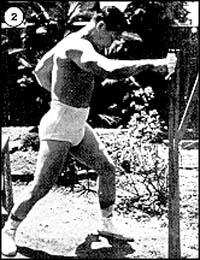 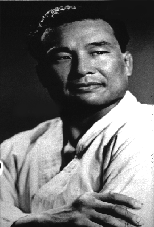
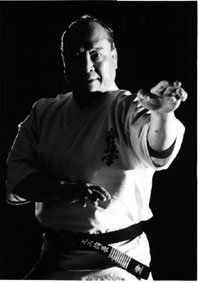
One hundred man
kumite
:
One feat which has not been repeated is the 300 man kumite (fight). Mas Oyama faced 100 fresh opponents each day over three days in bare fist fights, winning many of the fights by knockout. Legend has it that after three days he ran out of opponents. This challenge continues today in the form of the 100 man kumite. This is the ultimate challenge for the dedicated karate-ka (student) and to date, relatively few have successfully completed the challenge. Akiyoshi Matsui, who at 31 years of age was Mas Oyama's appointed head of Kyokushin and succeeded him when Mas Oyama passed away in 1994, is one who has done the 100 man kumite, demonstrating his superb skill and commitment.
Kyokushin Karate :
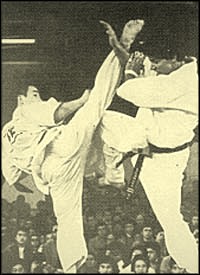
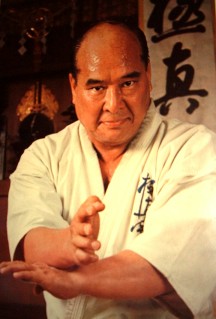
The Japanese refer to Mas Oyama's kyokushin karate
as kenka karate, meaning "brawling" or "brutal" karate. But Oyama tells his students "Baka! Kenka karate ja-nai! Budo karate da!" which translates to "Fool! This is not brawling karate! It's budo karate!"
Why does the general public seem to misunderstand Oyama's message? One look at a kyokushin karate tournament reveals the answer. Kyokushin karate fighters are among the fiercest in the world, and they will stop at nothing in their pursuit of victory. Kyokushin tournament sparring features full contact without protective padding. There are no weight classes; a fight ends only when one fighter proves beyond doubt his superiority, which almost always means his opponent is flat on the mat and may need to be carried away on a stretcher.
It does sound like a brawl, doesn't it? So why does Oyama refer to it as "budo karate"?
Perhaps because kyokushin fighters personify the budo (warrior) concept bet ter than any other karate stylists. Through his budo karate, Oyama is attempting to revive in the Japanese spirit the positive characteristics of bushido, the "way of the warrior," which was so much a of the culture of feudal Japan. In a ern world of peace and unification, many have forgotten this ancient code and see no need for the old warrior ethic. But in a time when it is no longer necessary to carry a sword for personal protection, the discipline of budo recreates in the hearts of its followers the do-or-die attitude of living life by the unspoken law of the sword. And that law is: Be prepared to make the greatest sacrifice (the sacrifice of one's own life) in the execution of one's endeavors, so that the resulting desire to overcome will be unequaled and the outcome will be the best possible.
This is not to say Oyama encourages his followers to take their own lives if their endeavors are unsuccessful, as was required of the warriors of Japan's middle ages. Instead, he emphasizes a way of thought that directly represents this ideal: The degree of personal sacrifice, in this case self-denial through self-discipline, is directly proportional to the degree of success in one's endeavors.
Not only has he adopted this, the strongest ideal of bushido, but Oyama has gone a step further by adopting the strongest attitude of another period in the development of Japan's martial spirit. In the Japanese middle ages, when several key military leaders became so powerful that they were able to unify the feuding states and maintain peace, the warrior class was no longer needed and military practices were for the first time practiced simply for the sake of the perfection of skill. Skills such as s wordsmanship, archery and horsemanship, that before had been considered useful only for military purposes, began to be practiced solely for the sake of the practice. The term "martial art" was born, and martial "artists" realized that the search for mastery in these military arts led directly to character-building and wisdom. The martial arts became a means for finding personal improvement, fulfillment and emancipation from the everyday trials of life. Thus, not only does the follower of Oyama's teachings find strength from personal sacrifice, but also learns that great personal spiritual advancements can be gained as a result of this sacrifice.
The third, and possibly greatest, addition by Oyama in his synthesis of kyokushin karate is the concept of Zen. In a Zen state of mind, one thinks nothing. The mind is completely cleared of all intruding thoughts and emotions. The mind simply relaxes; it does not focus precisely on any particular detail. The mind focuses on nothing, yet perceives everything. Can this concept not be put to great use in karate?
While fighting, you stand facing your opponent. When the opponent attacks, you must quickly determine an attack is coming, what form it will take, where it is aimed, etc. All of this information must be relayed to the brain, where the decision is made about how to react. The brain must send a message to the body, telling it how to defend itself. This entire process takes only a fraction of a second, but what if the incoming attack is a fraction of a second faster?
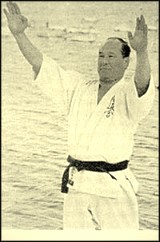
If, on the other hand, you are in a Zen state while in combat, you perceive not the individual attack, but the entire situation. Your mind and body act as one, bypassing the normal reaction time to automatically perform the necessary defense measure. The normal thought process in an attack is: perception, contemplation and, finally, reaction. With Zen, you can bypass the contemplation phase and react directly after perception. Oyama, having realized this, has gone so far as to say "Karate is Zen," a thus, he makes Zen an integral part of his system.
Thus, Oyama has not only integrated Zen with bushido and the "martial art" ideal of self-perfection from skill perfection, but he has also added perhaps the most important qualities of all into his kyokushin system: courtesy, respect, wisdom and humility. These concepts are needed to discipline the fighter, for a fighter who does not know how to control his strength, or does not know when it is appropriate to use his skill, is nothing more than a brute. According to Oyama, "Karate begins with courtesy and ends with courtesy."
Kyokushin Training
Now that you are familiar with the important philosophical ideals of Oyama's system, you might be wondering about the physical training in kyokushin karate.
Kyokushin kihon (basic exercises) are practiced at the beginning of every class. These basic techniques include: punching techniques using both seiken (forefist) and uraken (backfist); shuto (knife-hand) strikes; blocking techniques; and kicks.
All of the basic striking and blocking techniques (of which there are 16) are practiced from a sanchin stance, and each maneuver is generally repeated 30 times in rapid succession. A kiai (spirit yell) accompanies each technique. The 10 kicking techniques are performed either from zenkutsu-dachi (forward-leaning stance) or from a normal standing position. According to Oyama, "The practice of a technique only begins after 1,000 repetitions, and only reaches maturity after 10,000 repetitions."
While practicing basic kicking techniques, the kyokushin stylist always holds his belt just above his hips with both hands to limit his upper-body motion, thus forcing his waist and legs to do all of the work. Subsequently, when the kick is performed in a real situation, using the upper body, it will be much faster.
The basic kata (solo training sequences) of kyokushin are the three taikyoku forms. The intermediate kata are the five pinan sequences, and the advanced forms include tensho, kanku, seipai and
seiunchin.
In addition to kihon, kata and dojo kun practice, kyokushin students can expect instruction in ido-gekko (transfer training) and kumite (sparring). During ido-gekko practice, the kihon movements are repeated in a variety of stances and combinations while moving forward across the length of the dojo (training hall). This is the longest portion of class as each technique is repeated literally hundreds of times. Kumite usually comes at the end of class and, just as in kyokushin tournament competition, protective gear is not worn and blows are delivered with full contact. Surprisingly, however, serious injuries seldom occur, although bruises are inescapable.
The Heart of Oyama's Kyokushin
Three basic concepts are at the heart of Oyama's system: chikara-no-kyujaku (timing in the use of strength or focus); iki-no-chosetsu (control and timing of breathing); and waza-no-kankyu (the tempo of the technique). A common misconception among martial artists is that power comes from strength. Those who believe this tend to focus the energy in their muscles at a constant rate throughout each movement. This method is not only counterproductive because it wastes energy, but it also lessens the power of the technique. As any physicist will tell you, power (impact force) comes from acceleration (rate of change in speed); force is a result of mass and acceleration. It is therefore necessary to relax the muscles used when performing a technique to generate the highest possible speed. Then, just before impact, it is necessary to focus your energy (tense your muscles) to provide the mass behind the force. Relax first, focus second.
According to Oyama, the control and timing of one's breathing is the third tool necessary to attain optimum efficiency in the performance of a technique. When exhaling, your diaphragm tenses, causing the muscles to relax, thus reducing muscle opposition and accelerating your techniques. Therefore, you must exhale forcefully while performing a technique, but an instant before impact, cut short your breathing. By doing so, the diaphragm again relaxes and the muscles have a tendency to tighten, which adds force to the technique.
Oyama claims that an understanding of the control and timing of your breathing, combined with an understanding of focus and speed, are the keys to performing karate techniques in the best possible manner. "I can defeat anybody whose breathing I can hear from 10 feet away," Oyama has said.

Please click
here to go back to Karate page
|

















